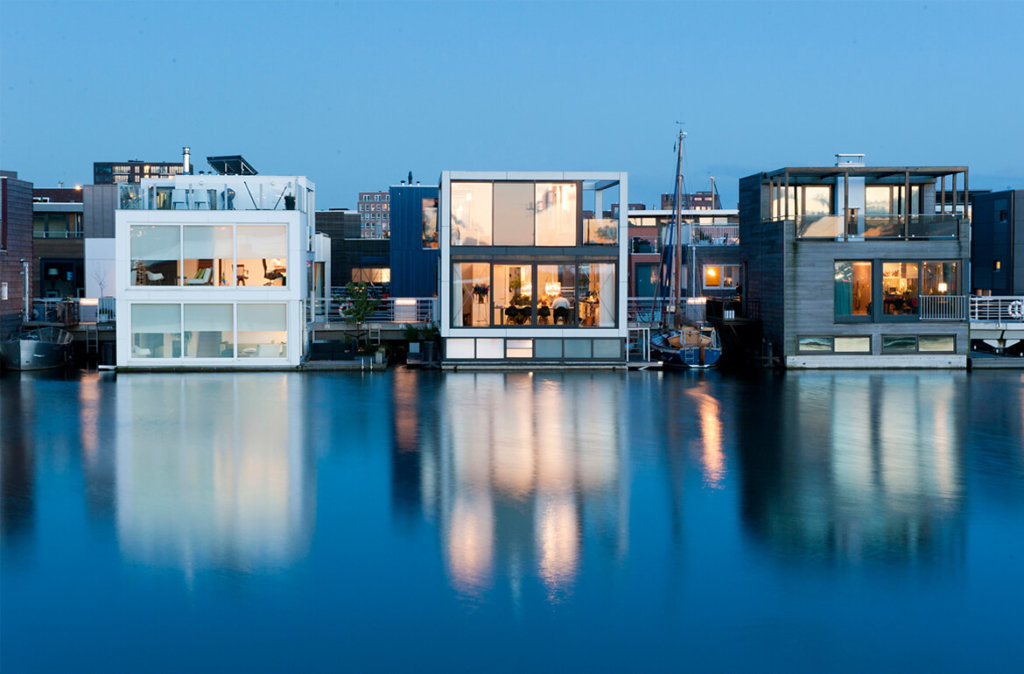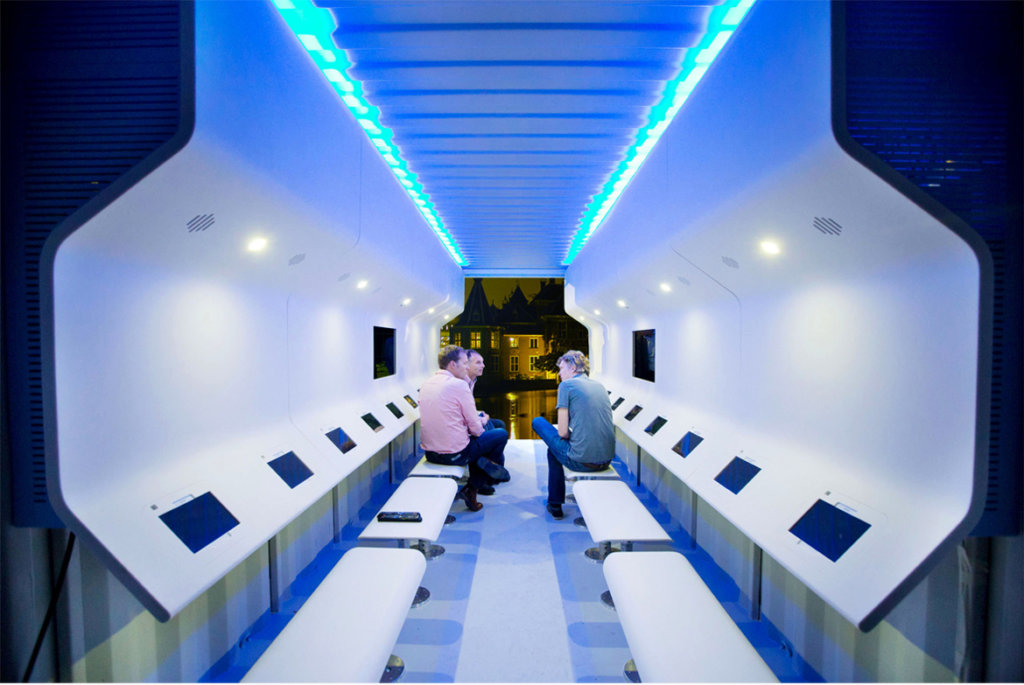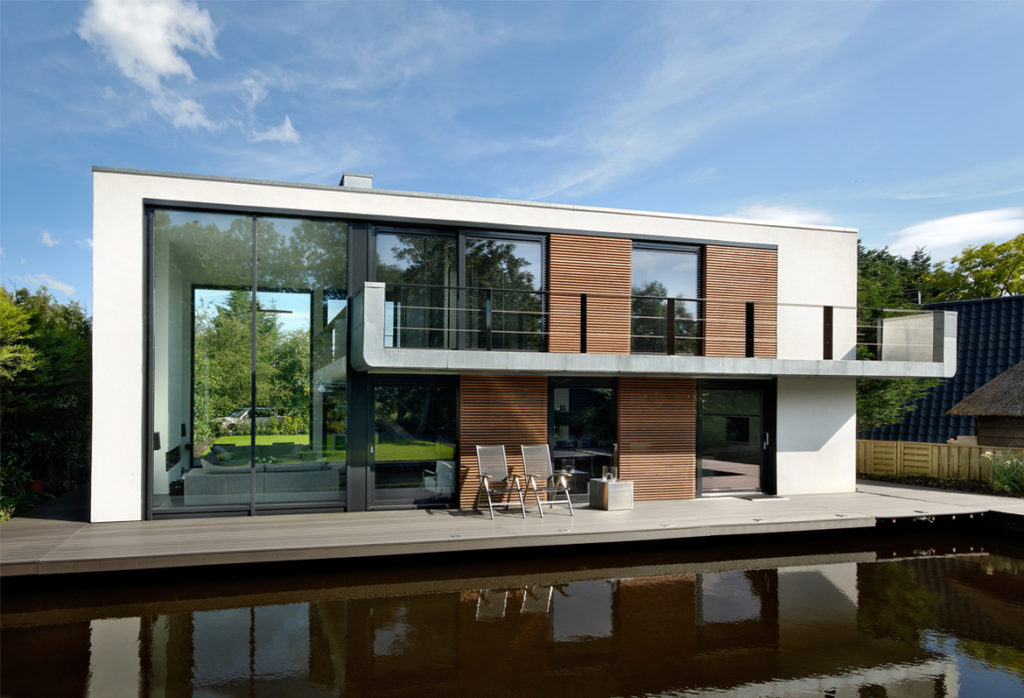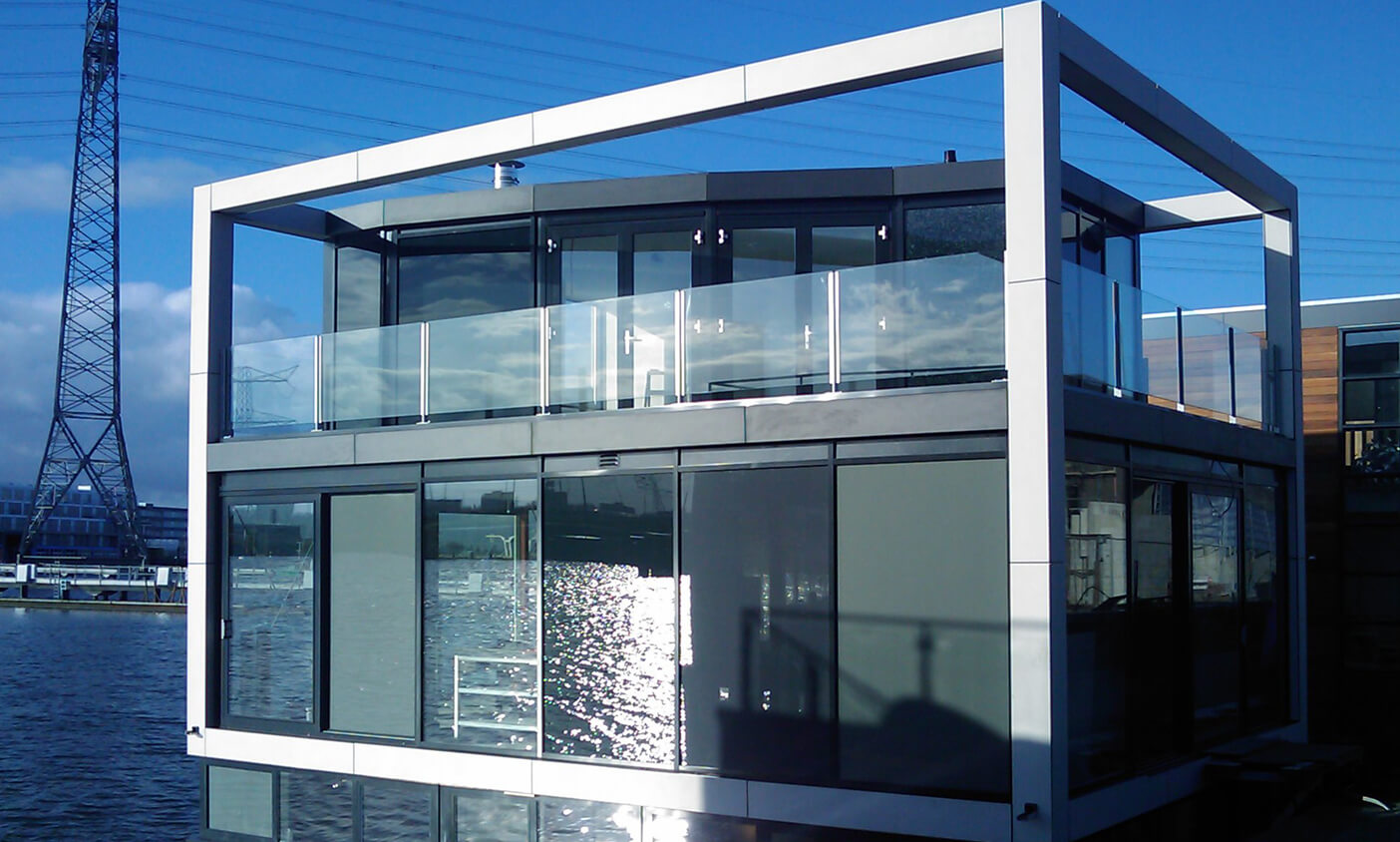Olthuis: ‘Bouw amfibische wijken in overstromingsgebieden’
By Architectenweb
September.5.2016
Over de hele wereld ontwerpt hij drijvende gebouwen, zelfs hele drijvende wijken; architect Koen Olthuis van Waterstudio.NL. Op donderdag 15 september geeft hij op Architect@Work een lezing over de mogelijkheden van drijvende steden. Architectenweb hield met de architect een voorgesprek.
“De steden die we al eeuwenlang op het land bouwen volgen ook maar een concept”, begint architect Koen Olthuis van Waterstudio.NL. “Het is een bewezen concept, maar ook een die niet optimaal functioneert. Onze boodschap is: kijk ook eens naar water en welke mogelijkheden dat biedt om tot een andere stedenbouw te komen.”
Water biedt de stad in Olthuis’ optiek veiligheid, ruimte en flexibiliteit. Om met dat laatste aspect te beginnen: met de verplaatsbaarheid van drijvende gebouwen kunnen steden veel minder statisch worden. De tijd die steden nodig hebben om te reageren op veranderende sociaal-economische vragen, de response time zoals Olthuis het noemt, kan dan flink omlaag.
Als voorbeeld noemt Olthuis steden die enkel in een bepaald seizoen gebruikt worden, seasonal cities. Kunnen die gebouwen off-season niet op een andere plek ingezet worden? “Laat steden met het gebruik meebewegen”, benadrukt Olthuis.
Dat sommige steden dicht bebouwd zijn, betekent volgens hem nog niet dat ze ten volle gebruikt worden. “Ik noem dat de efficiency van het gebruik.” Sommige functies kunnen op het water – als verplaatsbaar gebouw – intensiever gebruikt worden dan wanneer ze op het land zouden blijven.
In Libanon werkt de architect momenteel aan een drijvende woning die uit twee U-vormen bestaat. Hierbij heeft de buitenzijde van de U-vorm een gesloten gevel en de binnenzijde een open gevel. De toekomstige bewoners kunnen straks met beide bouwdelen spelen en ervoor kiezen om de woning volledig gesloten te houden, deze deels te openen, of deze helemaal te openen. Zo kunnen de bewoners bijvoorbeeld inspelen het veranderende klimaat door het jaar heen. Van volledig gesloten naar volledig geopend kost volgens Olthuis maar een paar uur tijd.
Amfibische steden
Wat betreft waterveiligheid vindt Olthuis het interessant wat momenteel in steden als Bangkok, Tokyo en Shanghai gebeurt. Het water heeft daar meer ruimte nodig. Daarom zijn er veiligheidszones ingesteld die nog niet ontwikkeld kunnen worden. Omdat ze bijvoorbeeld eens in de zoveel tijd onder water lopen. “Amfibische wijken of steden kunnen daar een uitkomst zijn.”
Een permanent drijvende woning biedt niet voor iedereen het gewenste comfort, geeft Olthuis toe. De meeste mensen wonen toch het liefst aan een straat met een eigen tuin. Een woning die normaal gesproken op de grond staat, maar bij een overstroming bijvoorbeeld eens in de vijf jaar korte tijd drijft, kan dan een uitkomst zijn.
“De grootste bedreiging in Nederland komt niet van de stijgende zeespiegel, maar van hoge waterstanden in de rivieren en hevige regenval”, stelt Olthuis. “Een aantal van de meer dan 3.500 polders in ons land zouden we daarom in moeten richten als noodopslag voor water. Hier kunnen vervolgens amfibische wijken gerealiseerd worden.” In China en Thailand werkt Olthuis al aan plannen voor dergelijke wijken.
Kansen in Nederland nog onbenut
Ondanks dit alles is het in Nederland de afgelopen jaren opvallend stil rond het bouwen op water. In Rotterdam wordt een drijvende boerderij gebouwd, in Amsterdam worden enkele tientallen waterkavels op de markt gebracht voor particuliere woningbouw. “Onder de 70.000 woningen die jaarlijks in Nederland gebouwd worden zijn misschien honderd waterwoningen.”
“Nederlandse ontwikkelaars zijn lui”, constateert Olthuis. “Nederland is op dit punt gewoon meer een innovatieland dan een uitvoerland.” De hele wereld bekijkend is de architect echter zeer optimistisch over drijvende architectuur. Overal is daar grote interesse in.
Richting architecten heeft Olthuis ook een boodschap: “Zie water als een extra ingrediënt in de stedenbouw dat veiligheid, ruimte en flexibiliteit biedt.”
Architect@Work vindt plaats op woensdag 14 september en donderdag 15 september in Rotterdam Ahoy. Als mediapartner heeft Architectenweb rond het thema architectuur en water een gevarieerd lezingenprogramma samengesteld. Binnen dit programma geeft architect Koen Olthuis van Waterstudio.NL op donderdag 15 september om 17:30u een lezing met de lengte van een uur.
De lezingen tijdens Architect@Work zijn gratis bij te wonen. Registreer je wel van tevoren even. Ga naar www.architectatwork.nl, klik op de knop Gratis Bezoekersregistratie en registreer je met de code 455.
AquaTecture, Buildings and cities designed to live and work with water
By Robert Barker & Richard Coutts
RIBA Publishing
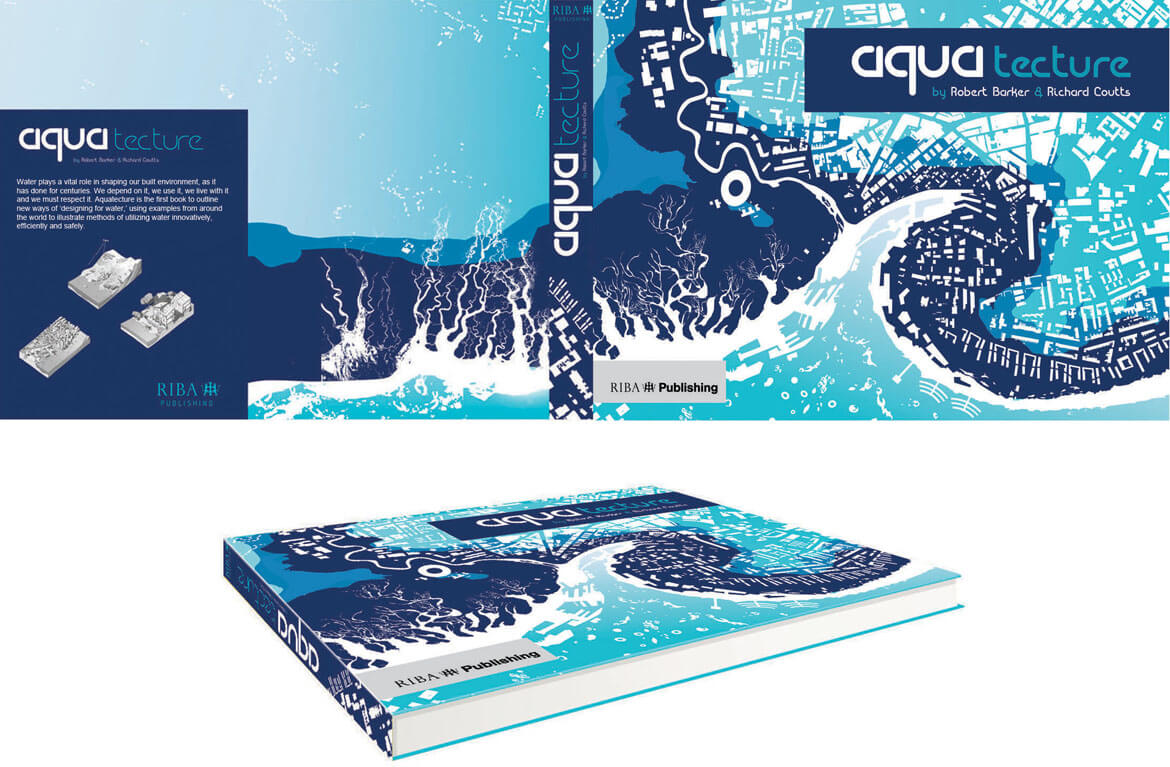
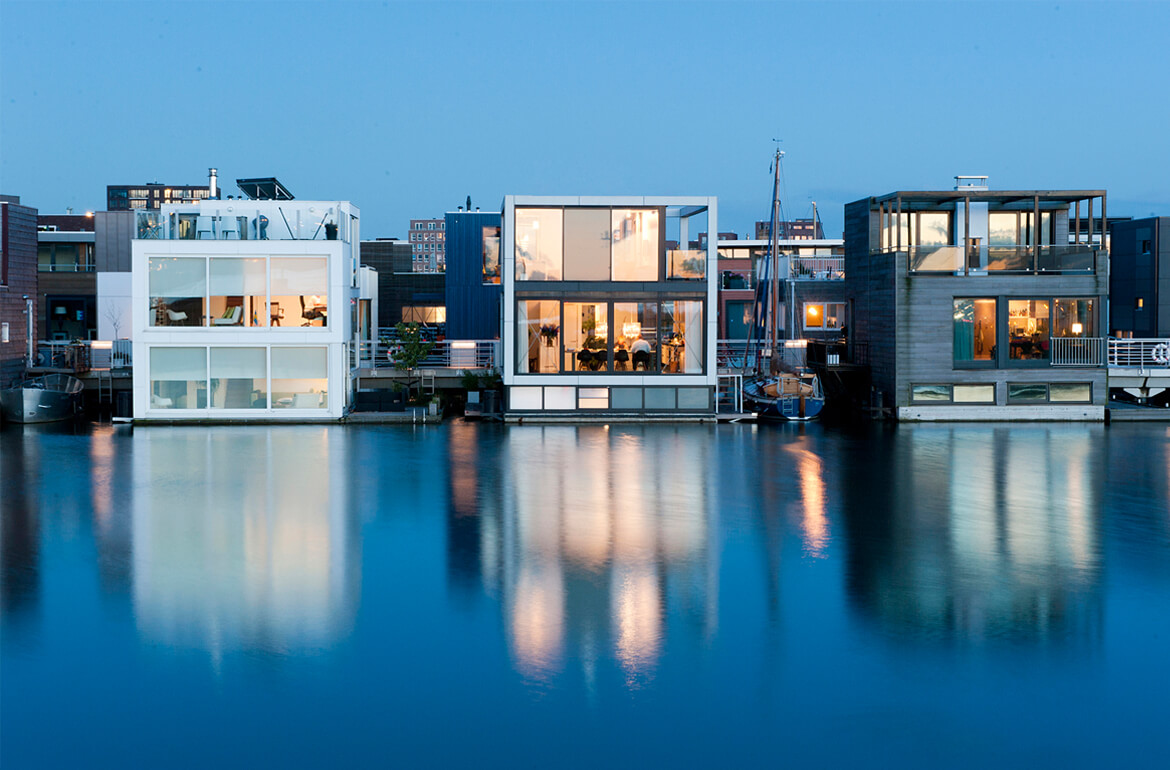
Water plays a vital role in shaping our built environment, as it has done for centuries. We depend on it, we use it, we live with it and we must respect it. Aquatecture is the first book to outline new ways of ‘designing for water,’ using examples from around the world to illustrate methods of utilizing water innovatively, efficiently and safely.
The first part of the book explores the historical relationship between water and architecture, examining how cities and civilisations have been drawn to water and have attempted to control it. The chapters go on to assess how this relationship has changed over time, and introduce readers to a range of brand new techniques that will revolutionise the way we think about water, design and urban planning. Solutions such as amphibious housing, wet-proof buildings, zero carbon development, rain gardens, flood storage and new methods of waterfront design are discussed and their effectiveness assessed.
Full colour illustrations and international case studies are used throughout the book to bring these new theories to life; practical, technical advice sits alongside truly ground-breaking and ambitious ideas for the future. This book is an ideal reference tool for all architects, urban designers, planners and sustainability experts who have an interest in creating a beautiful, sustainable, intelligent and pleasurable built environment on land, in water and with water.
An island of my own
By Zoe Dare Hall
The Daily Telegraph
July.2015
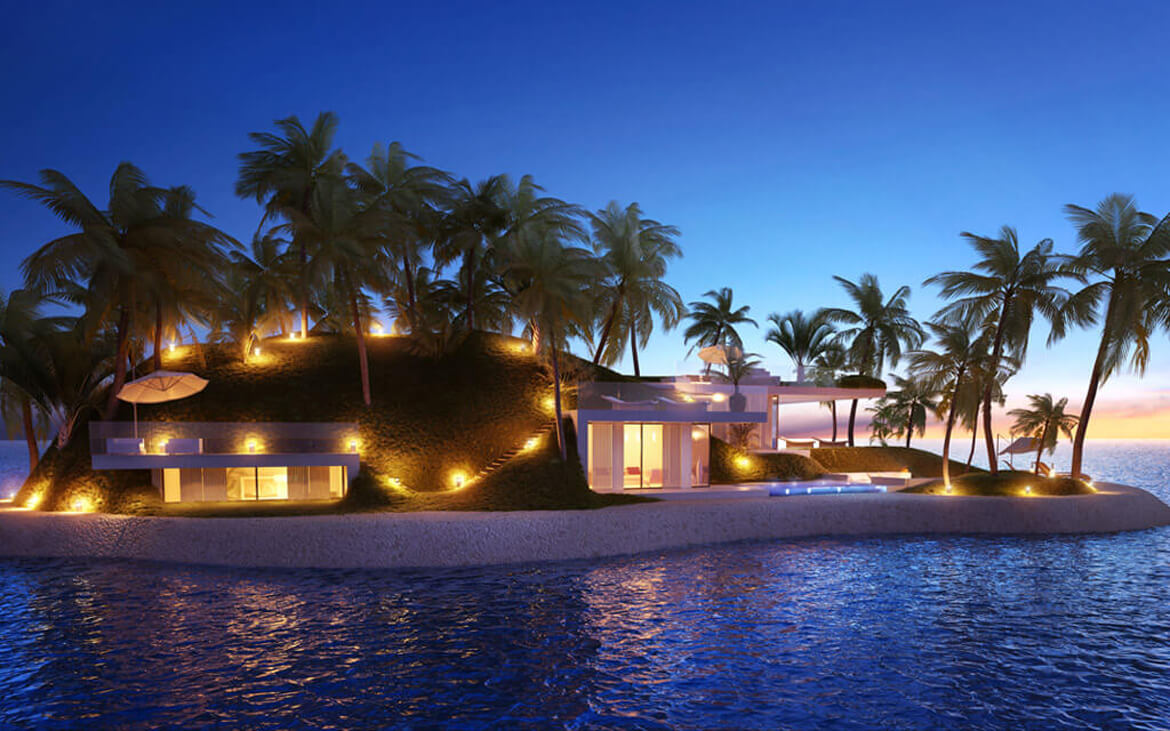
An island of my own
Your own private island cheaper than the average London home
An island might be the ultimate status symbol but 65 per cent are on sale for less than £350,000
In the rarefied world of trophy homes, there’s little that says “I’m absurdly rich” like having your own private island.
Johnny Depp has one in the Bahamas without even a house on it. “That’s a growing trend among island owners, especially celebrities, who like the idea of camping out and not leaving a footprint,” says Kate Everett-Allen, co-author of Knight Frank’s “Island Review”, which looks at the latest trends in island living.
Others prefer to share their private islands, such as Facebook founder Mark Zuckerberg, who recently paid around $100 million for a chunk of Kauai island in Hawaii.
And a growing band are renting rather than owning, giving them the freedom to island-hop according to the seasons. Knight Frank calls them “wealthy millennials”, while Farhad Vladi, founder of Vladi Private Islands, who deals with many of the world’s island sales, refers to them as the “Facebook generation who like the excitement of island living but not the responsibility of ownership”.
There are currently a few hundred islands for sale ranging from wild, untouched outcrops to luxury hideaways with palatial homes or exclusive resorts. Most expensive is the 222-acre Cave Cay in the Bahamas on sale for $90 million (£58.4 million) with a deep-water harbour, private airstrip and house – plus permission has been given for 38 more properties and a hotel. Or, if you have $62 million, you could buy Halls Pond Cay, which would make Mr Depp your neighbour, both through Vladi Private Islands (0049 40 33 89 89; vladi-private-islands.de).
But 65 per cent of private islands are on sale for less than $500,000, according to Knight Frank, and some are positively cheap if you don’t mind forsaking the warm-watered idyll for something a little nippier on the toes and off the beaten track.
There’s Porcupine Island in Nova Scotia, for example, which Vladi is marketing for just under £30,000. There’s nothing on it, but you get a house on the mainland 800m away as part of the package.
The growth of technology – and the use of private jets – is making islands an increasingly attractive work-and-play option for the super-rich. “It’s much easier if you can work somewhere you enjoy spending time, and with Skype and video conferencing people can work from their islands, as Richard Branson does on Necker,” says Edward de Mallet Morgan from Knight Frank’s international residential department. He’s marketing Yadua island in Fiji with a guide price of $2.5 million-$3 million (020 7629 8171; knightfrank.com) – currently undeveloped but with permission to build overwater and island properties.
Accessibility isn’t a problem for Yadua; it’s 10 minutes by helicopter from Fiji’s main Nadi international airport. But if there’s one issue that is deterring prospective island buyers, it’s the prospect of having to start from scratch, building the infrastructure, installing utilities and finding someone trustworthy to run your empire when you’re off-island.
Buck Island in the British Virgin Islands – price on request through Knight Frank – removes much of that hassle as it already has a 12-bedroom clifftop house surrounded by 43 acres of tropical beauty. “It’s ready to go and with Beef Island’s airport a quick helicopter trip away, you can be master of your own domain but you’re close enough to get away if you need to,” says de Mallet Morgan.
Or easier still is to join the growing band of ultra-rich who are happy to sacrifice being the sole king of the castle in favour of buying into exclusive island resorts – which are driving the 69 per cent increase in private jet flights to island destinations in the past decade, according to NetJets. In that period, the number of private flights doubled in Antigua, Ibiza, the Greek Islands and Majorca. For the super-rich who slum it by flying commercial, the rise in the number of routes to the Balearics has done wonders for their desirability.
“Until 2012, you couldn’t even get direct flights in winter to Ibiza. Now Ibiza and Majorca have an ever-increasing number of direct flights all year, good IT connectivity and sought-after international schools, making them an ideal place for the work/lifestyle balance for young professionals,” says Everett-Allen.
The Caribbean islands of Mustique and Jumby Bay are rare examples of wealthy island communities whose villa owners own a share of the island. “They feel like private villages rather than commercially run operations and Mustique now has fibre optic across the island so it’s easy to work remotely,” says de Mallet Morgan.
You’ll need deep pockets to join them. Many of Jumby Bay’s properties are like mini-resorts with their numerous pavilions, hotel-like leisure facilities and private stretches of beach. The eight-bedroom Ty Molineux, set on eight beachfront acres, is Jumby’s biggest and priciest home, on sale for $28.5 million through Knight Frank. Annual running costs notch up a further few hundred thousand dollars a year (though you can recoup that through prime-season rentals).
On Mustique, the Balinese-style Mandalay – built in 1969 for David Bowie to include his recording studio in a pavilion hidden in the tropical gardens – (pictured below) is on sale for $20m (£13m), also through Knight Frank.
The appeal of luxury island life is also on the up in Bali, which had the greatest price growth in 2014, up by 15 per cent according to Knight Frank, followed by Mustique and Ibiza, in which property prices increased by five per cent. In Ibiza, Calaconta – where the huge, modern villas cost from €2.95 million (£2.10 million) through Knight Frank – has brought a new touch of luxury and concierge services to a peacefully remote spot on the south-west coast.
Barbados, meanwhile – whose properties had one of the highest number of online viewings among island markets last year, according to Knight Frank – may be too developed to offer the sense of getting away from it all, but its property is reaching ever more incredible heights of luxury to cater to the super-rich crowd in search of its inimitable brand of West Coast island luxury.
New to the market is Palazzate, a 75,000 sq ft beachfront mansion near Speightstown with an unprecedented price tag for the island of $125 million (001 246 262 8112; palazzate.com), while a little further down the coast is Platinum Bay, a new development of five beachfront villas that cost from $25 million (020 7647 7667; platinumbaybarbados.com) and come with “bespoke” concierge services tailored to each owner’s demands.
It’s not just the prospect of the hard work and continual expense that is leading to the world’s wealthiest steering away from buying their own private outcrop in favour of a ready-made, like-minded island community. They also face stiff competition from governments, NGOs and environmental organisations who are snapping up undeveloped islands to preserve the natural habitat.
“Ecology is becoming the buzzword for private islands and governments are landbanking them, partly to conserve them but they can also be an electoral winner,” says Knight Frank’s Everett-Allen.
The Canadian government is on an island-buying spree, currently purchasing 100 land masses in Nova Scotia. “It’s also happening in Europe and the Caribbean. There are no privately owned German islands left on the ocean now,” says Vladi, who calculates there are around 12,000 private islands in the world and only about 1,000 of them are developed and likely to remain privately owned.
“As soon as you build a marble palace on your island, it will be out of reach of the nature groups and remain in private hands. But undeveloped islands such as Ginger Island in the BVIs, on sale for $16 million, are ripe for purchase by the local government or conservationists,” he adds.
But while islands in private hands may be dwindling in number, new ones – despite what Mark Twain once famously said about investing in land – are starting to emerge.
Volcanic eruptions are creating new islands each year in Tonga, Russia and Japan, according to Knight Frank, and the growing need for “aquatecture” (homes that will withstand or repel flooding) is leading to the creation of new floating islands such as Amillarah, newbuild, eco-friendly private islands with villas priced from $10 million in Dubai, the Maldives and Miami (0096 033 36664; amillarah.com).
Whether you want to lord it alone over your own land mass or join a select group, whether you buy or rent, build a mansion or camp out like Johnny, there is no lack of luxury island living on offer around the world. And this is one trophy purchase for which you don’t even need to be a billionaire.
Ces conceptions et techniques qui font du risque un atout
By Focus

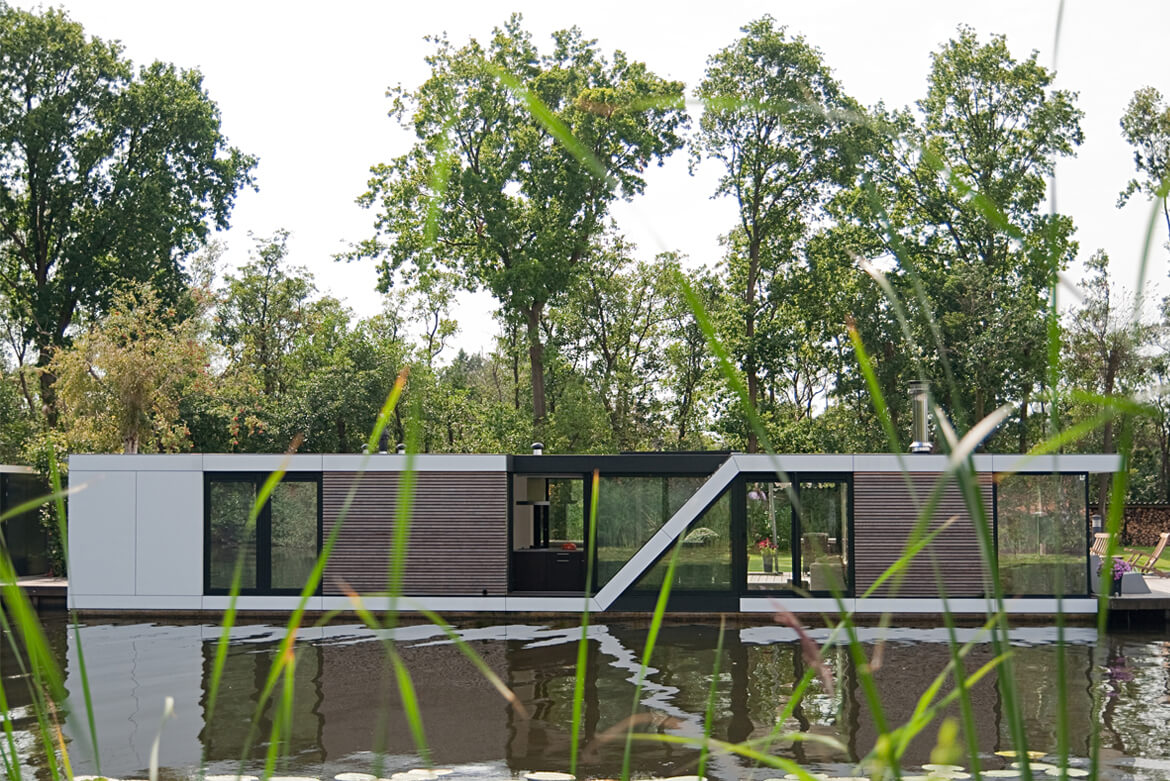
Le cahiers techniques du bâtiment, Dossier risques climatiques
Ces conceptions et techniques qui font du risque un atout
Face a la montee des eaux et aux inondations de plus en plus frequebtes, certains architectes imaginent des solutions constructives qui depassent le simple cadre de l’habitat individuel. l’habitat flottant developpe aux Pays-Bas peut etre une source d’inspiration.
Green light for Dubai’s first private floating islands
By Parag Deulgaonkar
Emirates 24|7
June.2015
Oqyana World First to have 33 floating houses with own beach, garden and pool
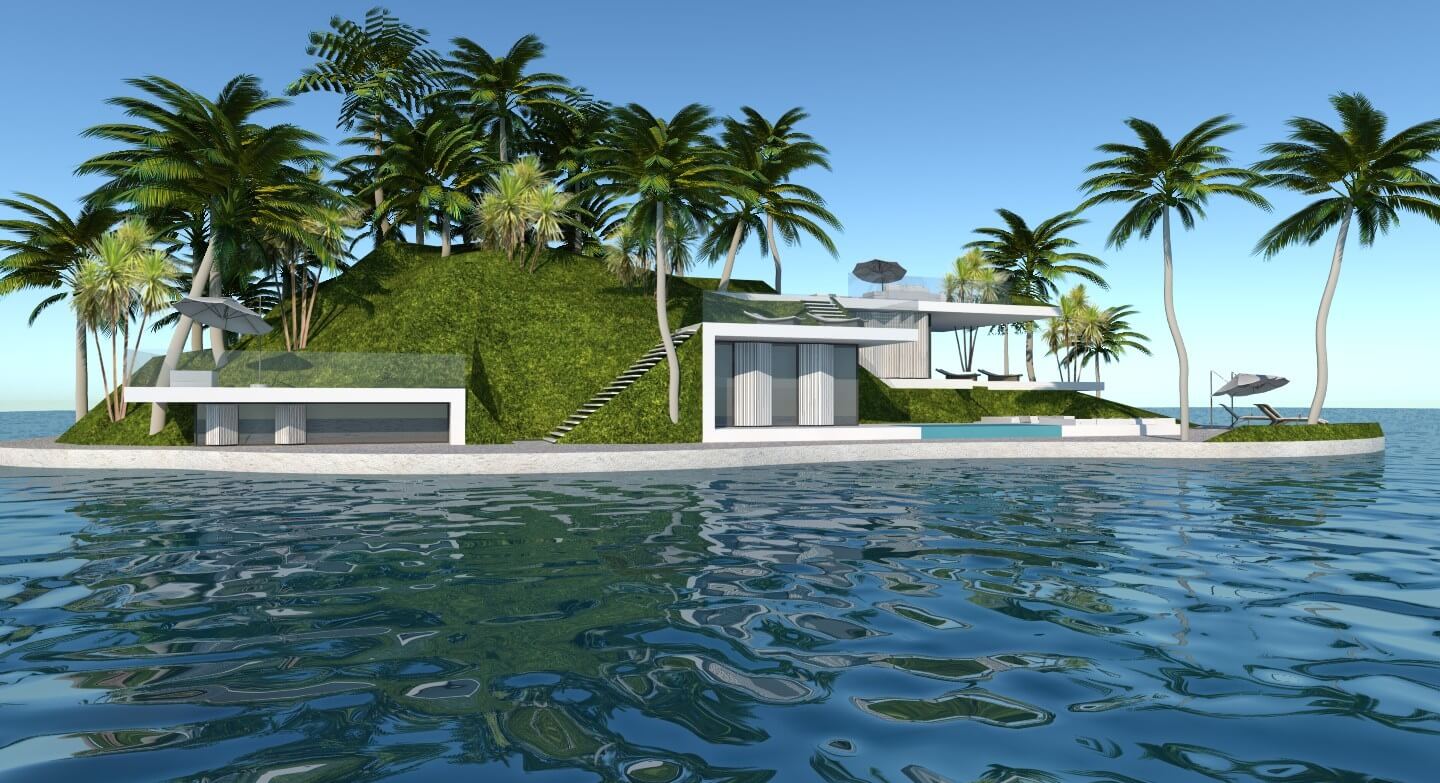 Oqyana Real Estate and Amillarah Private Islands will create will be 33 luxury floating private islands with each having a garden, pool and beach. (Supplied)
Oqyana Real Estate and Amillarah Private Islands will create will be 33 luxury floating private islands with each having a garden, pool and beach. (Supplied)
Dubai-based Nakheel has given the go-ahead to the developer of the floating islands, which are part of Oqyana World First, on The World, an artificial archipelago of over 300 islands, according to the project developers.
“Nakheel has now granted our project with all the necessary permits in order to take the next step,” Oqyana Real Estate and Amillarah Private Islands said in a joint statement.

The developer claims it was the ‘first’ floating project ‘officially approved’ on The World, which has been developed by Nakheel, a wholly-owned government entity.
In January 2015, the two companies signed a deal to create a series of floating private islands as part of the project located on Australasia.
There will be 33 luxury floating private islands with each having a garden, pool and beach.
“We are offering floating private islands, tailor made to the clients specifications, based on our Dutch heritage of hundreds of years of working with the water,” Paul van de Camp, CEO, Amillarah, told Emirates 24|7.
“We do not want to start any sales before all permits are granted and all technical details are engineered.”
Completely stable on the water, the base of the island is built to last for far over 100 years and will create a new underwater habitat for sea life, the company states, adding, it is building similar islands in Maldives and in Miami in the US.
Oqyana World First comprises high-end villas, apartments, hospitality and retail elements.
In May 2015, this website reported that Kleindienst Group, developer of the Heart of Europe development on The World, had sold 35 of 42 Dh6.5-million ‘floating seahorses’, which will have the master bedroom and bathroom totally submerged underwater, to Gulf Cooperation Council nationals, Europeans and Indians.
The World
The World project is nine-kilometres wide and seven-kilometres long.
It covers an area of 931 hectares and will add 232km to Dubai’s natural 67km of beachfront.
The islands range from 150,000 to 450,000 square feet in size.
The project is divided into private estate island zones, commercial zones, which have low/mid/high density resorts, hubs for ferry transfer points and public visitor areas.
Unique floating villa in Amsterdam for sale
This unique floating villa located in IJburg, Amsterdam is now for sale.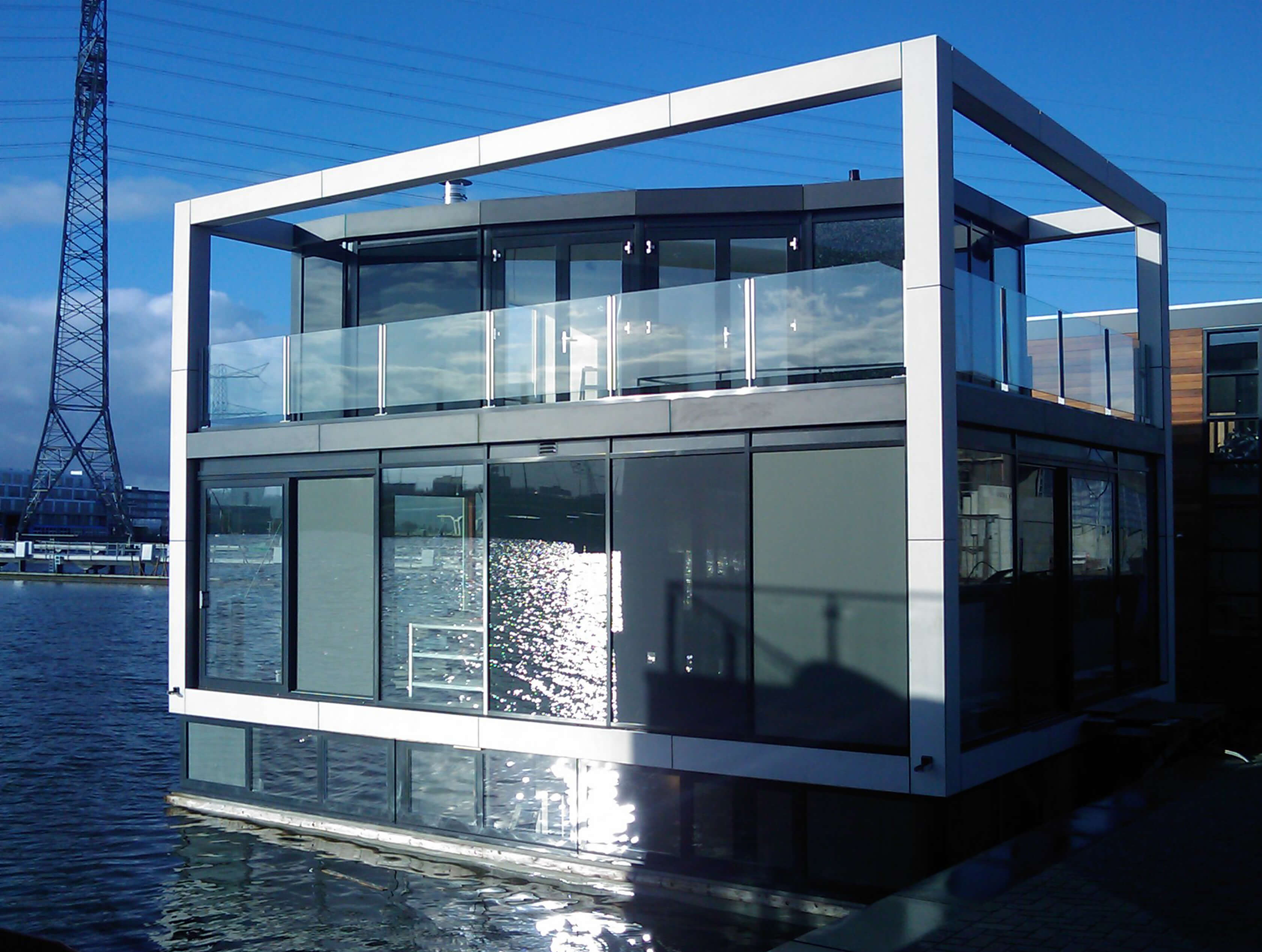
Vingt mille lieux sur les mers
By Frederic Joignot
Le Monde
Vinght mille lieux sur les mers: Comment les architectes voient la vie sur l’eau
Projet “Citadel” d’appartements, agence Waterstudio (Hollande). Il s’agit de construire dans des polders ouverts des habitations flottantes adaptées à la montée des eaux. C’est une “citadelle” parce qu’il s’agit “du dernier rempart contre la mer”, disent les architectes.
Un vieux rêve de l’humanité est de se réfugier sur une île pour y refaire sa vie, voire le monde, inventer une société meilleure, expérimenter des voies nouvelles pour l’humanité. C’est sur une île que Thomas More situait Utopia (1516), sa société idéale, au cœur d’une île encore que Tommaso Campanella imaginait la Cité du Soleil (1602) ou Sir Francis Bacon La Nouvelle Atlantide(1624), menée par les philosophes. Aujourd’hui, ces utopies insulaires sont rattrapées par la réalité terrestre : construire des cités écologiques sur des îles nouvelles est devenu un mouvement architectural. Né dans l’urgence de la menace environnementale, ce courant qui a gagné l’urbanisme interpelle, depuis dix ans, économistes, institutions internationales et gouvernements.
Ce mouvement a un drapeau – bleu, couleur des océans – et un pays pionnier : les Pays-Bas. Elu en 2007 parmi les personnes les plus influentes de l’année par le magazine Time, l’architecte Koen Olthuis, cofondateur de l’agence Waterstudio, à Ryswick, est l’un de ses praticiens et théoriciens. Il signe ses mails Green is good, blue is better (« le vert [le souci écologique], c’est bien, le bleu, c’est mieux ») et avance plusieurs arguments pour expliquer pourquoi construire sur les mers est une idée d’avenir : « D’ici 2050, 70 % de la population mondiale vivra dans des zones urbanisées. Or, les trois quarts des plus grandes villes sont situées en bord de mer, alors que le niveau des océans s’élève. Cette situation nous oblige à repenser radicalement la façon dont nous vivons avec l’eau. » Car, rappelle-t-il, les cités géantes du XXIe siècle sont mal en point : « La préoccupation “verte” qui saisit aujourd’hui architectes et urbanistes ne suffira pas à résoudre les graves problèmes environnementaux des villes. Comment allons-nous affronter les problèmes de surpopulation ? De pollution ? Résister à la montée des eaux ? » Sa réponse : en bâtissant des quartiers flottants, de nouvelles îles, en aménageant des plans d’eau pour un urbanisme amphibie. « La mer est notre nouvelle frontière », affirme l’architecte, détournant la formule de John Fitzgerald Kennedy. Car si l’espace manque sur terre, la mer est immense – et inhabitée.
Waterstudio n’est pas la seule agence néerlandaise à développer cette vision « bleue ». Plusieurs cabinets d’architecture et entreprises expertes, reconnues internationalement, bâtissent déjà sur l’eau. Il faut rappeler qu’aux Pays-Bas, contrée où l’on compte 3 500 polders et des villes sillonnées de canaux, s’adapter et résister aux assauts de la mer et aux inondations est une activité séculaire indispensable : en 1953, une violente tempête a causé près de 2 000 morts et provoqué l’évacuation de 100 000 personnes. Ce savoir-faire est devenu symbolique de la lutte de l’homme face à une nature menaçante, perturbée par le changement climatique. Désormais, « le monde est un polder », écrivait le biologiste Jared Diamond dans Effondrement. Comment les sociétés décident de leur disparition ou de leur survie (Gallimard, 2006).
Sauf que les polders, ces terres artificiellement gagnées sur l’eau, ne suffisent plus. Waterstudio a notamment conçu des maisons flottantes à IJburg, un quartier expérimental au sud-est d’Amsterdam. D’autres projets maritimes sont en cours. En 2009, l’agence a dessiné le projet Citadel, une cité flottante de 60 appartements installée dans un polder délibérément ouvert aux eaux. « Nous l’appelons Citadel, car ce sera la dernière ligne de défense contre la mer », explique Koen Olthuis, pour qui ce projet « montre clairement les possibilités infinies de la construction sur l’eau »
Au pays des polders, le fait de bâtir des immeubles flottants offre un complet renversement de perspective : « Nous cherchons à nous adapter à la mer, à l’accompagner, plutôt que lutter avec elle », explique l’architecte. Quand les habitations flottent, nul besoin de pomper l’eau, de renforcer en permanence les digues. Un nouvel urbanisme s’invente, où des quartiers entiers, jardins et maisons, reposent sur l’eau, parfois ancrés au sol, parfois mobiles. Une telle conception, avance l’architecte, va bouleverser toutes nos habitudes urbaines. Elle nous oblige à revoir « notre vision statique des villes » : la terre habitée ne sera plus tout entière « ferme ». Elle nous engage à repenser notre « exigence du sec » sur des territoires protégés par les digues, pour vivre sur l’eau. Elle annonce la multiplication d’habitats flottants et amphibies sur les zones côtières.
« Une ville plus mouvante, plus dynamique, se dessine. Certains habitats et services se déplaceront. L’urbanisme, la vie citadine vont en être transformés », conclut Koen Olthuis. Il n’est pas le seul à le penser. Du 26 au 29 août, signe des temps bleus à venir, se tiendra à Bangkok Icaade 2015, la première conférence internationale sur l’architecture amphibie. A Lagos, au Nigeria, l’architecte Kunlé Adeyemi a conçu une école flottante pour les enfants du bidonville de Makoko, sur la lagune. Posée sur des barils, équipée de panneaux solaires, elle a été inaugurée en février 2013. Kunlé Adeyemi prévoit de bâtir une flottille de maisons sur le même principe.
Les architectes de l’agence DeltaSync, à Delft, aux Pays-Bas, ont synthétisé ces idées dans un manifeste architectural et économique : « Blue Revolution ». Si les terres viennent à manquer, écrivent-ils, « où irons-nous ? Dans le désert ? Les ressources en eau manquent. Dans l’espace ? C’est toujours trop cher. Reste l’océan ». Notre planète de rechange est là. Car 71 % de la surface terrestre est maritime. Le texte continue : « Ce siècle verra l’émergence sur l’océan de nouvelles cités durables (…). Elles contribueront à offrir un haut standard de vie à la population, tout en protégeant les écosystèmes. Un rêve ? Non, la réponse au principal défi du XXIe siècle. »
L’agence DeltaSync, qui a construit en 2010 un pavillon flottant dans le port de Rotterdam, conseille le gouvernement néerlandais sur ses projets d’aménagement urbain, travaille sur la flottabilité et la stabilité de l’architecture aquatique. Elle développe avec l’université des sciences appliquées Inholland un projet de parc sur l’eau dans le port du Rhin, à Rotterdam : imaginez un petit archipel abritant un marché, une piscine, des restaurants, un centre de sport, une salle de concert. L’idée pourrait être reprise dans plusieurs villes néerlandaises, dans les ports ou sur des polders ouverts.
Un autre projet conçu pour un bassin portuaire est le Sea Tree, l’arbre de mer. Conçu par Waterstudio, encore dans les cartons, il révèle une autre dimension de l’architecture bleue : son exigence écologique. Il s’agit d’une haute structure en terrasses, entièrement végétalisée, construite selon les principes de la technologie offshore. Chaque grande ville côtière pourrait en installer. Ces arbres maritimes géants pourraient aider à lutter contre l’épuisement environnemental des grandes cités : ils comporteront des potagers verticaux et des terrasses plantées pour nourrir les citadins, ils capteront le CO2, ils abriteront quantité d’animaux utiles – oiseaux, abeilles, chauves-souris insectivores – qui rayonneront sur la côte et la ville proche. A Manhattan, à Singapour, les municipalités réfléchissent sérieusement à en installer, assure-t-on à Waterstudio.
On retrouve, dans ce projet de tour portuaire, plusieurs des idées-forces du courant dit de l’« architecture écologique », en plein essor. C’est un autre volet stratégique de la construction « bleue » : récupérer et consolider les principes de la construction « verte ». Autrement dit, s’appuyer sur les énergies durables (éolien, solaire, chauffage passif, géothermie), végétaliser les terrasses et les toits, intégrer les immeubles à l’écosystème local, s’inspirer des formes naturelles. L’architecte malaisien Ken Yeang, l’un des théoriciens de cette écoarchitecture, auteur de The Green Skyscraper (« Le gratte-ciel vert », non traduit, Prestel, 1999), a poussé cette réflexion très loin : selon lui, un immeuble doit être conçu dès l’origine comme un « système vivant construit », afin de pouvoir entrer « en symbiose » avec son environnement : sobre en énergie, recyclable, bioclimatique, l’habitat doit participer du cycle naturel, réintégrer la biosphère et dépolluer, tel un arbre colossal.
Pour bâtir cette cité aquatique, il faudra d’abord concevoir des grands caissons flottants de différents formats qui s’emboîteront jusqu’à former des îlots constructibles. Les premières unités doivent être mises en chantier cette année. Les commanditaires ont hâte de les tester : la pollution des grandes villes chinoises est telle que les autorités envisagent de construire rapidement à l’écart des zones atteintes. Sur l’eau, en face des cités enfumées. Demain, ces cités pourraient abriter une partie de la population littorale, désengorger les mégapoles, être économes en énergie, alléger la dégradation environnementale
Que répondent les architectes « bleus » à ces critiques et à ces risques d’une pollution aggravée ? Ils soulignent qu’ils ne veulent pas construire des îles artificielles, mais flottantes, qui n’altéreront pas les fonds marins. Et ils avancent un nouvel argument de poids : au XXIe siècle, l’humanité (9,6 milliards d’habitants attendus en 2050) va rencontrer de graves problèmes de terre arable, d’épuisement des stocks halieutiques et d’alimentation – toutes choses qui inquiètent beaucoup l’Organisation des Nations unies pour l’alimentation et l’agriculture (FAO). A Londres, pour les concepteurs de la Floating City, la cause est entendue : seule une future « colonisation » des mers permettra d’arrêter la conquête des terres par la ville. Ils écrivent : « La biologie terrestre a été soumise depuis longtemps à une exploitation si intensive que les terres encore inexploitées doivent être préservées de l’urbanisation. De nouvelles colonies maritimes devront être planifiées au XXIe siècle. »
C’est sur cette problématique de la disparition et de l’épuisement des sols, associée à une crise alimentaire, que les défenseurs de l’urbanisme marin rejoignent un autre volet de la « révolution bleue » : la croissance exponentielle de l’aquaculture mondiale depuis vingt ans. En 2008, selon un rapport de la FAO, l’aquaculture a fourni 46 % des poissons à l’échelle mondiale. Il s’agissait à 87 % de poissons d’eau douce, mais l’aquaculture marine est en progression constante, ainsi que l’algoculture et la conchyliculture (élevage des mollusques marins). Cela se comprend : la pèche industrielle menaçant d’épuiser les stocks de nombreux poissons, l’aquaculture apparaît comme une réponse viable pour nourrir les populations, même si elle rencontre de sérieux problèmes de gestion durable.
Or, les architectes bleus avancent que l’avenir de l’aquaculture maritime passera par l’édification de fermes et de bassins nourriciers à proximité des cités côtières. C’est l’idée qui est derrière un projet de l’agence DeltaSync, « Floating food cities will save the world » (« les villes alimentaires flottantes sauveront le monde »), développé par l’ingénieur Rutger de Graaf. Imaginant une nouvelle forme d’économie circulaire, il explique que la construction de récifs artificiels accueillant poissons et crustacés, de bassins d’aquaculture aquaponique recyclant les éléments nutritifs apportés par les déchets des villes flottantes, et d’îles agricoles permettra de nourrir les populations urbaines côtières. Selon lui, il suffirait que 1 % des mers soient consacrées à l’aquaculture pour nourrir l’humanité – le reste des eaux devant être sanctuarisé. Une étude de faisabilité accompagne ces projets
Les partisans de l’architecture « bleue » avancent enfin qu’elle devrait permettre d’éviter un des drames possibles du changement climatique : la submersion de nombreuses îles du fait de la montée des eaux. Le gouvernement des Maldives y croit, qui a lancé en 2010 un programme de constructions sur l’eau afin d’accueillir les populations menacées et de sauver le tourisme : des projets de villages amarrés mais aussi d’îlots de plaisance, d’hôtels et de golfs flottants sont à l’étude. Ces réalisations pionnières, encore très élitistes − « Les riches paient pour les prototypes qui serviront à tous », explique Koen Olthuis –, sont étudiées de près par les Etats insulaires d’Océanie, qui ont lancé en juillet 2014, lors du 45e Forum des îles du Pacifique, un appel de détresse aux pays industrialisés.
Ils ont rappelé que l’archipel de Kiribati, où vivent 110 000 personnes, risque de devenir inhabitable en 2030 – même si certains scientifiques assurent que les atolls vont s’élever avec les mers. Les autorités ont d’ores et déjà acquis 2 400 hectares dans les îles Fidji pour les reloger. Le président de la République des Kiribati, Anote Tong, a aussi évoqué la possibilité de construire une « île flottante » pour les futurs réfugiés climatiques. Or, deux projets de ce type existent dans les cartons des architectes bleus. Le premier, un ensemble de trois îlots végétalisés, agricoles, supportant une tour d’habitation géante, est étudié par le constructeur japonais Shimizu Corp.
Living Above and Below the Water
By Christopher F. Schuetze
The New York Times
April.23.2015
Living Above and Below the Water’s Surface in Amsterdam

Floating houses built on man-made islands make up the new neighborhood of IJburg in Amsterdam. Center, the home of Monique Spierenburg and Kees Harschel, whose seven-meter sailboat is docked right next to the living room. CreditFriso Spoelstra, Boat People of Amsterdam, Lemniscaat, 2013
AMSTERDAM — When asked about his three-story floating house in a gleaming new part of Amsterdam, Kees Harschel, a 65-year-old native Amsterdammer, likes to compare his living situation to winning the lottery.
“This house fits us like a second skin,” said Mr. Harschel, a retired physical education teacher, sitting in his dining room on the ground — or in this case water-level — floor of the house he has shared with his wife, Monique Spierenburg, since the couple had it built seven years ago.
In Mr. Harschel’s case, the comparison with a game of chance is more than just pride of ownership: To become part of the community of 36 houses floating on an artificial lake on Steigereiland, one of several man-made islands that make up the burgeoning new neighborhood of IJburg, Mr. Harschel competed with more than 400 applicants.
“My wife said: Go on, gamble — you won’t win anything, so try it,” said Mr. Harschel, who lived in a house on the Amstel river before moving to IJburg. But winning a spot in the small community — which the couple did in 2007 — was just the first step in a journey that would include hiring a renowned architect and battling the bureaucratic wrangling that comes with being a building pioneer in Europe.
The result is an expression both of one couple’s love of the water and of innovative living for which the Dutch — long known for their centuries-old ornate houses — are garnering an international reputation.
IJburg, home to about 20,000 people currently, is expected to eventually house 45,000. It has been rising over the past decade on a succession of artificial islands to the southeast of the city center, conceived to ease a chronic housing shortage. The area attracts many young families and professionals who, with a newly built tram line, can be in the heart of Amsterdam in 10 minutes.
The city has taken care to create a mixed community, with mansions, social housing and both market-rate and fixed-rent apartments, all sharing courtyards, public squares, parks, shopping centers and canals.
And while the 36 houses in Mr. Harschel and Ms. Spierenburg’s part of the neighborhood are all individually designed and built, those across the lake are by a single developer. Some are rented and some are owned by their inhabitants.
The couple’s house, which is nine meters, or 30 feet, high, rises just seven and a half meters above the water surface (the submerged 1.5 meters is part of the fully functional bottom floor) and is seven meters wide and 10 meters deep. (The width of the house is set by the size of the lock connecting the IJmeer to the little lake that would become its home.) Over all, the design accommodates 175 square meters of total floor space, or 1,880 square feet, with a 35-square-meter roof terrace.
The interior is the essence of Dutch simplicity. The main floor has a kitchen and dining room, where the couple do most of their socializing. Vast windows ensure the interior is flooded with diffuse reflected light and offer views of the IJmeer and the rest of the floating neighborhood.
The top floor is divided between an indoor living room and an outdoor patio. When the doors are open in the summer, the space becomes one, evoking architecture from much warmer climates.
Built to suit the couple, the basement includes two bedrooms, a master bathroom, an infrared sauna, a study and, according to Mr. Harschel, one of the most important rooms in the house: a two-and-a-half-square-meter woodworking and repair shop.
Although the house feels like a normal house, it is actually floating on its concrete basement foundation. (Power, water and other services are supplied via the fixed dock, which also acts as the land access, installed and maintained by the city.) Eye-level windows in the basement afford just-over-surface views.
Its unusual construction allowed the house to be built miles away from where it now floats, and if Amsterdam’s building code did not forbid it, the owners could simply take it with them when they moved.
“I’m a sailor,” said Mr. Harschel, who pilots saloon boats — canal boats often used for private day trips — around Amsterdam. His seven-meter Thalamus Working Boat is docked right next to the living room.
“On summer evenings we can just take some beer, wine and toast and have dinner out on the water,” said Mr. Harschel, who last summer sailed to the south of England, departing from and returning to the side of his house.
On the rare occasion when the lake freezes over, Ms. Spierenburg straps on her speed skates and takes to the ice without having to leave her house to reach the rink.
“It is much more a gateway to freedom than it is just a place to live,” said Koen Olthuis, who designed this house and whose architectural office, Waterstudio, specializes in designing floating buildings all over the world. “Skating around the house, swimming around your house — it’s marvelous.”
Both owner and architect concede that being one of the first houses on the pier came with costs.
“They paid a bit for the things we learned,” said Mr. Olthuis, explaining that the pioneering families did pay — in money, time and frustration — for what the city was learning about urban planning on water.
“It was a book this thick, but we were free,” joked Mr. Harschel, waving an imaginary building code volume.
Mr. Olthuis noted that the house had been built following code for land houses, which, in keeping with a mandate to build greener houses in the Netherlands, stipulated triple-glazed windows, heavy insulation and even a heat exchanger to retain heat from effluent — something that most houseboats, which tend to be light houses on a heavy foundation, avoid.
Mr. Harschel estimates that the couple spent 350,000 euros, or $380,000, to build the house (the lease for the lot is €600 a month), and guesses that the value of the property has probably more than doubled in the years since it was built.
“These people living here are pioneers; they are willing to take a risk, they are willing to try stuff out,” said Mr. Olthuis. “They all have a very strong feeling of freedom. That’s why they came here.”
Thailand tests floating homes in region grappling with floods
By Alisa Tang
Thomson Reuters Foundation
March.2015
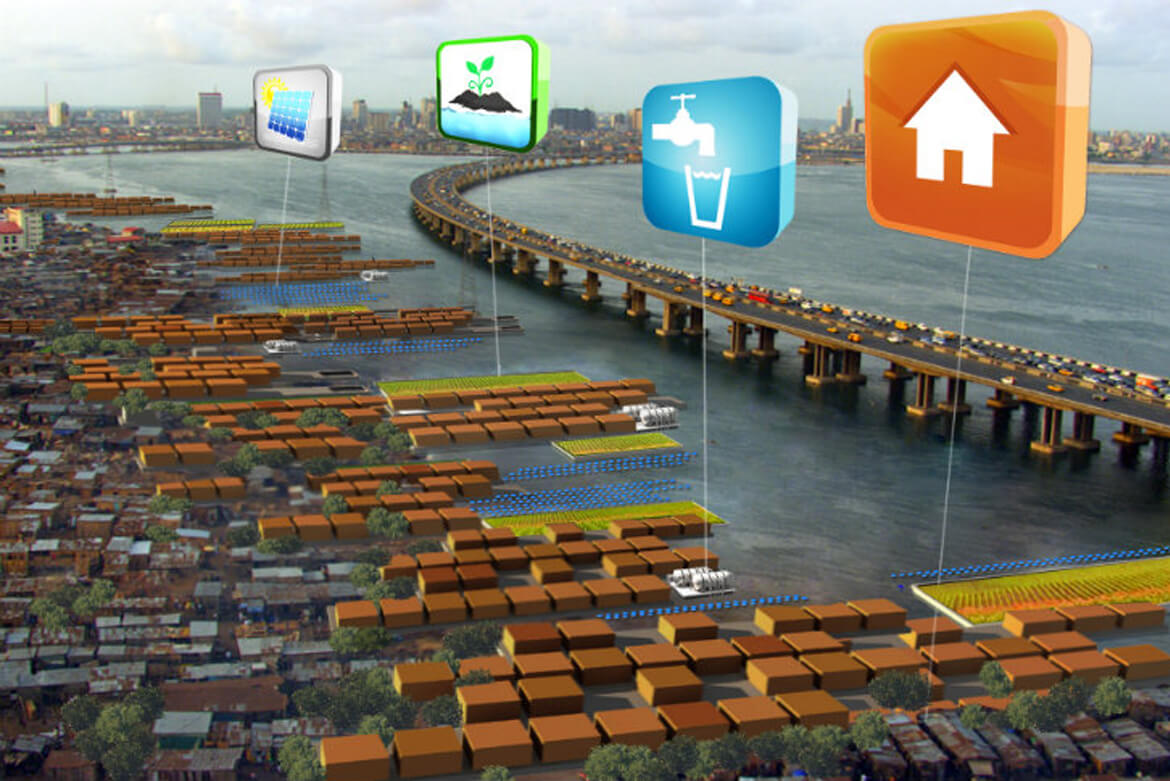
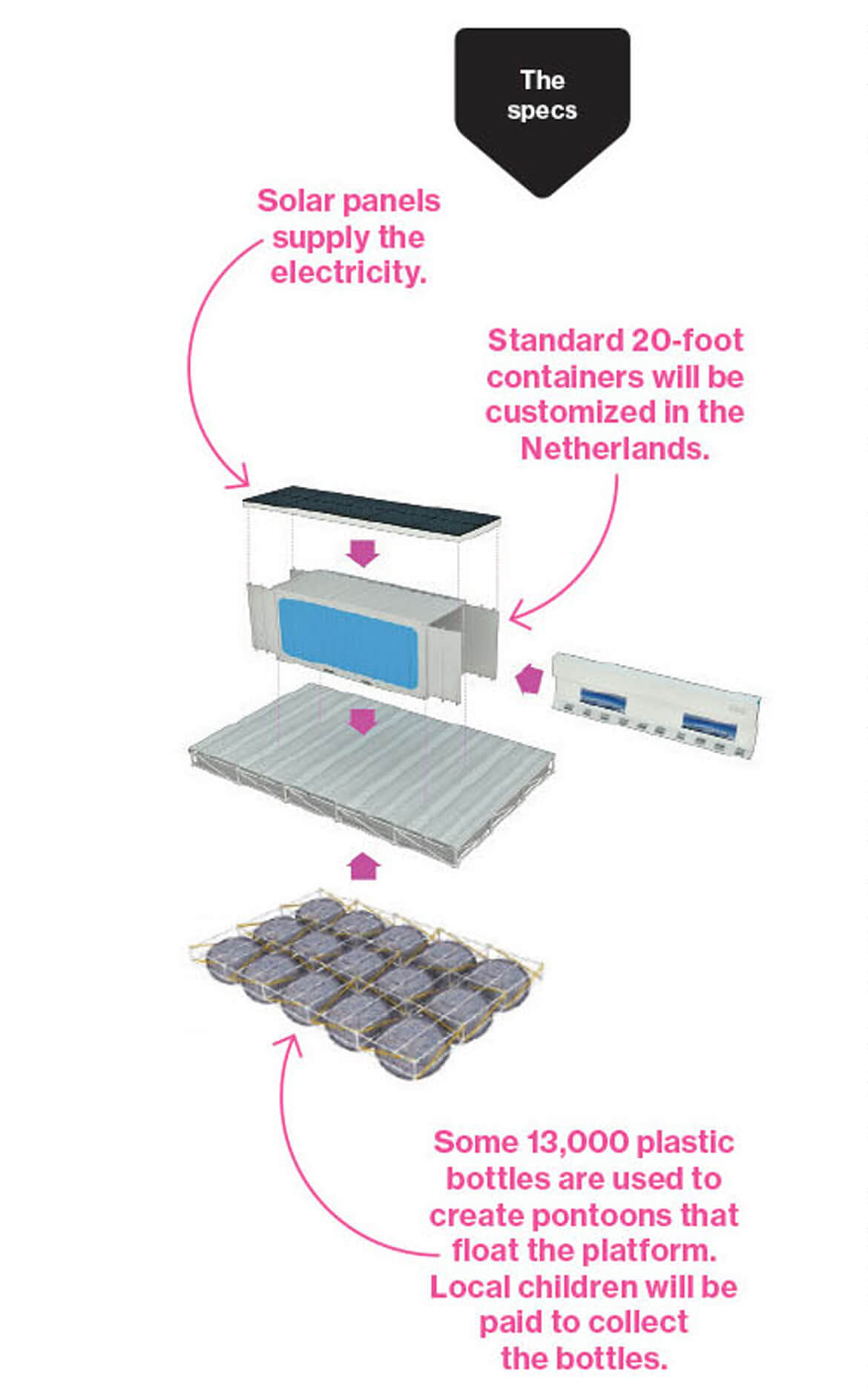
In this picture provided by Site-Specific Co Ltd, the 2.8 million baht ($86,000) amphibious house, designed and built by the architecture firm Site-Specific Co Ltd for Thailand’s National Housing Authority (NHA) rises up 85cm after architects and NHA staff fill a manmade test hole underneath the house with water during a trial run in Ban Sang village of Ayutthaya province September 7, 2013. REUTERS/Site-Specific Co Ltd/Handout via Reuters
AYUTTHAYA, Thailand (Thomson Reuters Foundation) – Nestled among hundreds of identical white and brown two-storey homes crammed in this neighborhood for factory workers is a house with a trick – one not immediately apparent from its green-painted drywall and grey shade panels.
Hidden under the house and its wraparound porch are steel pontoons filled with Styrofoam. These can lift the structure three meters off the ground if this area, two hours north of Bangkok, floods as it did in 2011 when two-thirds of the country was inundated, affecting a fifth of its 67 million people.
The 2.8 million baht ($86,000) amphibious house in Ban Sang village is one way architects, developers and governments around the world are brainstorming solutions as climate change brews storms, floods and rising sea levels that threaten communities in low-lying coastal cities.
“We can try to build walls to keep the water out, but that might not be a sustainable permanent solution,” said architect Chuta Sinthuphan of Site-Specific Co. Ltd, the firm that designed and built the house for Thailand’s National Housing Authority.
“It’s better not to fight nature, but to work with nature, and amphibious architecture is one answer,” said Chuta, who is organizing the first international conference on amphibious architecture in Bangkok in late August.
Asia is the region most affected by disasters, with 714,000 deaths from natural disasters between 2004 and 2013 – more than triple the previous decade – and economic losses topping $560 billion, according to the United Nations.
Some 2.1 billion people live in the region’s fast-growing cities and towns, and many of these urban areas are located in vulnerable low-lying coastal areas and river deltas, with the poorest and most marginalized communities often waterlogged year-round.
For Thailand, which endures annual floods during its monsoon season, the worsening flood risks became clear in 2011 as panicked Bangkok residents rushed to sandbag and build retaining walls to keep their homes from flooding.
Vast parts of the capital – which is normally protected from the seasonal floods – were hit, as were factories at enormous industrial estates in nearby provinces such as Ayutthaya. Damage and losses reached $50 billion, according to the World Bank.
And the situation is worsening. A 2013 World Bank-OECD study forecast average global flood losses multiplying from $6 billion per year in 2005 to $52 billion a year by 2050.
FLOATING HOUSE
In Thailand, as across the region, more and more construction projects are returning to using traditional structures to deal with floods, such as stilts and buildings on barges or rafts.
Bangkok is now taking bids for the construction of a 300-bed hospital for the elderly that will be built four meters above the ground, supported by a structure set on flood-prone land near shrimp and sea-salt farms in the city’s southernmost district on the Gulf of Thailand, said Supachai Tantikom, an advisor to the governor.
For Thailand’s National Housing Authority (NHA) – a state enterprise that focuses on low-income housing – the 2011 floods reshaped the agency’s goals, and led to experiments in coping with more extreme weather.
The amphibious house, built over a manmade hole that can be flooded, was completed and tested in September 2013. The home rose 85 cm (2.8 feet) as the large dugout space under the house was filled with water.
In August, construction is set to begin on another flood-resistant project – a 3 million baht ($93,000) floating one-storey house on a lake near Bangkok’s main international airport.
“Right now we’re testing this in order to understand the parameters. Who knows? Maybe in the future there might be even more flooding… and we would need to have permanent housing like this,” said Thepa Chansiri, director of the NHA’s department of research and development.
The 100 square meter (1,000 square foot) floating house will be anchored to the lakeshore, complete with electricity and flexible-pipe plumbing.
Like the amphibious house, the floating house is an experiment for the NHA to understand what construction materials work best and how fast such housing could be built in the event of floods and displacement.
FLOATING CITIES?
The projects in Thailand are a throwback to an era when Bangkok was known as the Venice of the East, with canals that crisscrossed the city serving as key transportation routes. At that time, most residents lived on water or land that was regularly inundated.
“One of the best projects I’ve seen to cope with climate-related disasters is Bangkok in 1850. The city was 90 percent on water – living on barges on water,” said Koen Olthuis, founder of Waterstudio, a Dutch architecture and urban planning firm.
“There was no flood risk, there was no damage. The water came, the houses moved up and down,” he said by telephone from the Netherlands.
Olthuis started Waterstudio in 2003 because he was frustrated that the Dutch were building on land in a flood-prone country surrounded by water, while people who lived in houseboats on the water in Amsterdam “never had to worry about flooding”.
His firm now trains people from around the world in techniques they can adapt for their countries. It balances high-end projects in Dubai and the Maldives with work in slums in countries such as Bangladesh, Uganda and Indonesia.
One common solution for vulnerable communities has been to relocate them to higher ground outside urban areas – but many people work in the city and do not want to move.
Olthuis says the solution is to expand cities onto the water.
Waterstudio has designed a shipping container that floats on a simple frame containing 15,000 plastic bottles. The structure can be used as a school, bakery or Internet cafe.
Waterstudio’s aim is to test these containers in Bangladesh slums, giving communities flood-safe floating public structures that would not take up land, interfere with municipal rules or threaten landowners who don’t want permanent new slums.
“Many cities worldwide have sold their land to developers… and now when we go to them, we say, ‘You don’t have land anymore, but you have water,’” Olthuis said. “If your community is affected by water, the safest place to be is on the water.”
Reporting by Alisa Tang, editing by Laurie Goering
Our Standards:The Thomson Reuters Trust Principles.



